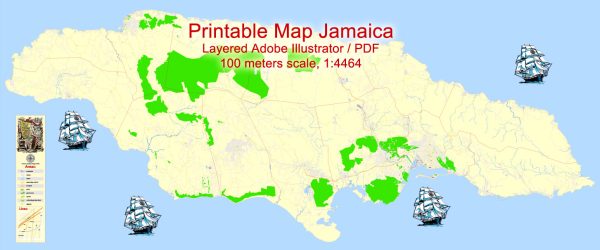Jamaica, an island nation located in the Caribbean Sea, relies on maritime and air transportation to facilitate trade, tourism, and overall connectivity. Here’s a brief description of both modes of transportation in Jamaica:
Maritime Transportation:
- Ports: Jamaica has several major ports, with the most significant ones being the Kingston Container Terminal in Kingston, the Port of Montego Bay, and the Port of Ocho Rios. These ports serve as crucial gateways for the import and export of goods.
- Shipping: The maritime industry in Jamaica is vital for international trade. The country exports agricultural products such as bananas, sugar, and coffee, while importing goods like machinery, vehicles, and consumer products. Container shipping is a common mode of transport for these goods.
- Cruise Tourism: Jamaica is a popular destination for cruise ships, with major cruise ports in Montego Bay, Ocho Rios, and Falmouth. These ports cater to a significant influx of tourists, contributing to the country’s tourism industry.
- Fishing Industry: Fishing is an important economic activity in Jamaica, and many coastal communities depend on it for their livelihoods. Small-scale artisanal fishing and larger commercial fishing operations contribute to the country’s seafood production.
Air Transportation:
- Airports: Jamaica has several airports, with the two main international airports being Norman Manley International Airport in Kingston and Sangster International Airport in Montego Bay. These airports handle a large volume of both domestic and international flights.
- Airlines: Several international and regional airlines operate in Jamaica, connecting the country to major cities around the world. These airlines facilitate the movement of passengers and cargo, supporting tourism and trade.
- Tourism: Air transportation plays a crucial role in Jamaica’s tourism industry. The country is a popular vacation destination, and tourists from various parts of the world arrive by air. The availability of direct flights to Jamaican airports contributes to the growth of the tourism sector.
- Domestic Flights: While international flights are essential, domestic flights also play a role in connecting different parts of the island. Smaller airports, such as those in Negril and Ocho Rios, cater to domestic flights and enhance accessibility within Jamaica.
In summary, Jamaica’s maritime and air transportation infrastructure is integral to the country’s economic activities, including trade, tourism, and local connectivity. These transportation networks contribute significantly to Jamaica’s position in the Caribbean region and its global interactions.


 Author: Kirill Shrayber, Ph.D.
Author: Kirill Shrayber, Ph.D.